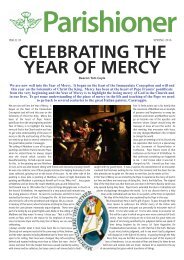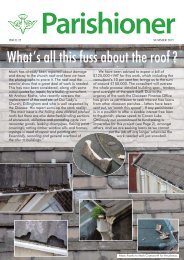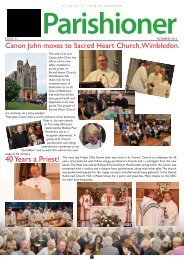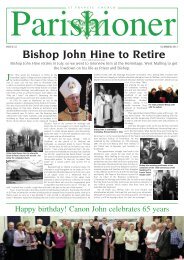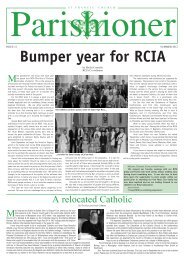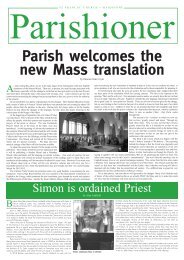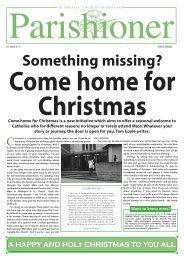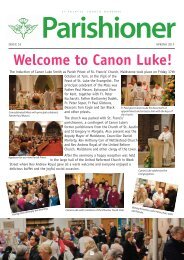The Parishioner - Edition 18
The Parishioner is the quarterly publication of St. Francis' Catholic Parish, Maidstone.
The Parishioner is the quarterly publication of St. Francis' Catholic Parish, Maidstone.
You also want an ePaper? Increase the reach of your titles
YUMPU automatically turns print PDFs into web optimized ePapers that Google loves.
NEWS IN<br />
PICTURES<br />
Blessed Margaret of Castello<br />
Picture and words by Charlotte Cassidy<br />
A GENEROUS OFFER<br />
Fr Michael Woodgate, Spiritual Director at St John’s, Wonersh<br />
Members of both St. Francis choirs were treated to a<br />
delicious spread at the home of Geraldine Sowerby<br />
on a sunny afternoon last summer.<br />
To mark the end of the Parish Mission, a Social was<br />
held at St Simon Stock School on Saturday 17th<br />
October. <strong>Parishioner</strong>s danced to the band ‘Highly<br />
Strung” and there was an excellent Finger Buffet,<br />
a licenced bar and Raffle. It was a very happy<br />
occasion. Many thanks to Martin Sexton for<br />
arranging everything.<br />
Bishop John Hine celebrates the 10.30 am Mass on<br />
Sunday <strong>18</strong>th October for the 150th Anniversary of<br />
the founding of St. Francis’Parish.<br />
After the Anniversary Mass parishioners pack the<br />
Parish Hall for a delicious reception prepared by<br />
ladies of the parish.<br />
Members of the choir team look pleased with their<br />
prizes after coming first (by one point!) at the<br />
Quiz Evening in the Parish Hall on Saturday, 23rd<br />
January. Proceeds of the evening went to the<br />
Maidstone Day Care Centre<br />
☺Father Joe walked<br />
into his church and<br />
spotted a man sitting<br />
cross-legged on<br />
the altar.<br />
“My son”, said the priest,<br />
“What are you doing? Who<br />
are you?<br />
“I’m God,” said the stranger.<br />
“Pardon?”<br />
“I’m God”, he repeated. “This<br />
is my house!”<br />
Father Joe ran into the presbytery<br />
and, in total panic,<br />
rang the Archbishop.<br />
“Archbishop,” he said, “I hate<br />
to trouble you but there’s a<br />
man sitting on my altar who<br />
claims he’s God. What shall I<br />
do?”<br />
“Take no chances,” said the<br />
Archbishop, “Get back in the<br />
church and look busy!”<br />
In the spring of 1287, the townspeople of<br />
Metola in Umbria, Italy, were excited by the<br />
news that Lord Parisio and his wife Lady<br />
Emilia, were expecting their long awaited first<br />
child. To mark the forthcoming birth, lavish celebrations<br />
were in preparation. Lord Parisio and his<br />
wife were elated as they anticipated the birth of a<br />
healthy son and heir to the family wealth or a beautiful<br />
daughter who would eventually marry into a<br />
noble Italian family.<br />
<strong>The</strong> child born to the couple was a dwarf. Her<br />
right leg was shorter than her left, she was totally<br />
blind, her face slightly disfigured. She was not a<br />
pretty baby. Her parents were devastated! In those<br />
days, many aristocratic families considered a<br />
handicapped child unacceptable.<br />
Lord Parisio immediately cancelled all<br />
planned festivities. Ashamed of their newborn<br />
infant, the couple entrusted the baby to a servant<br />
girl to care for the child secretly. Lord Parisio<br />
announced to relatives and friends that the baby<br />
was stillborn.<br />
<strong>The</strong> servant girl named the baby Margherita (later known to the word as<br />
Magaret) and as Margaret grew she remained small for her age. Because of<br />
her shorter leg she walked with a pronounced limp and she also developed<br />
a hunchback. She was allowed to walk around the castle as long as she<br />
avoided the areas frequented by her parents. Margaret quickly learned her<br />
way around and would often hobble to the castle’s private chapel to pray.<br />
One day as Margaret was praying alone a family friend met her by chance<br />
and almost discovered her true identity.<br />
When her father learned of the incident he decided that Margaret could<br />
no longer remain within the castle and so he had a small, secluded cell built<br />
for her in the forest next to the parish church of Santa Maria. <strong>The</strong> cell had<br />
two windows, a narrow window with bars through which food could be<br />
passed to her and a second window into the chapel which would allow<br />
Margaret to hear Mass and to receive Holy Communion from the parish<br />
priest, Fr. Silvestro. When the cell was completed, six-year-old Margaret<br />
was placed into it and the doorway walled up. Her only visitors were the castle<br />
servants, who brought her food each day, and Fr. Silvestro who pitied her<br />
immensely. Her parents never visited her.<br />
For the next fourteen years the little girl lived alone and confined in this<br />
small stone cell. Fr Silvestro befriended her and taught her prayers, psalms<br />
and the Holy Scriptures. She was a pious, intelligent child with a happy disposition<br />
and he was amazed by the depth of her spirituality. In her small cell,<br />
Margaret’s love for Jesus deepened and later, speaking to Fr. Silvestro, she<br />
said, “ Father, as you know, Jesus was rejected even by His own people, and<br />
God is letting me be treated the same so that I can follow Our dear Lord<br />
more closely.”<br />
In 1307, when Margaret was twenty, news came to Metola of a shrine<br />
in the nearby city of Castello where many sick and crippled pilgrims had<br />
been miraculously cured at the tomb of Br. Giacomo, a saintly Third Order<br />
Franciscan monk. Margaret’s parents, who were still unable to accept their<br />
daughter’s physical imperfections, decided to take her to the shrine in the<br />
hope that she would be cured of her disabilities.<br />
On arrival at the church of the shrine Margaret’s parents told her to join<br />
the sick and crippled pilgrims at Br. Giacomo’s tomb and to pray for a miracle.<br />
After two days they observed her still in prayer at the tomb and realising<br />
that she had not been cured they decided to return home without her<br />
vowing never to see her again.<br />
That evening when all the pilgrims, except<br />
Margaret, were gone, she came outside and sat in<br />
the church doorway to wait for her parents to take<br />
her back to Metola, and she fell asleep. When she<br />
awoke at dawn the following morning she managed<br />
to make her way to the nearby inn where her<br />
parents had stayed and was told they had left. It<br />
was then she realised that they had abandoned her<br />
completely. Although free at last from the cruel<br />
confines of her small cell she was now homeless,<br />
penniless and alone in Castello, a city totally unfamiliar<br />
to her.<br />
That afternoon some beggars befriended<br />
Margaret. She joined them, lived their harsh way<br />
of life and begged on the streets of Castello with<br />
them. She would always offer to pray for the<br />
passers-by who gave alms to her and her beggar<br />
companions and she became known for her kindness.<br />
Some of the women of Castello then decided<br />
to take Margaret into their homes. She helped the<br />
women with domestic chores and she especially<br />
loved the company of their children. She would<br />
teach the children psalms, prayers and passages of the Bible that Fr.<br />
Silvestro had taught her as a child. A kind peasant woman named Grigia,<br />
with a large family of her own, adopted Margaret and soon Grigia’s home<br />
became a meeting place for townspeople seeking Margaret’s prayers and<br />
spiritual guidance.<br />
Throughout all the difficult times of her life Margaret’s love for Jesus<br />
never wavered. She found strength through prayer and she would always<br />
unite her interior and physical sufferings to the suffering of Christ on the<br />
Cross. Although she had never had sight she often received heavenly visions<br />
of scenes from the Joyful Mysteries of the Rosary. She would describe these<br />
visions to Grigia saying, “Oh, if only you knew what I have in my heart”<br />
Inspired by Margaret’s holiness, the Mother Superior of a Dominican<br />
convent in Castello invited her to join the Sisters in the convent. Margaret<br />
accepted and was clothed in the habit of a Third Order Dominican nun. She<br />
lived an exemplary life of charity, prayer and penance and dedicated her life<br />
to the care of the poor people of the city. She made prisoners her special<br />
ministry and each day would bring them food, clothing and medicine and<br />
prayed with them.<br />
When the Mother Superior of the convent died Margaret returned to the<br />
home of her friend Grigia where she continued her charitable work for poor<br />
people and prisoners until her death on April 13th 1320. She was only thirty-three<br />
years old.<br />
When the townspeople learned of Margaret’s death they converged in<br />
the parish church of San Domenico and demanded that Margaret be regarded<br />
as a saint and buried in a tomb within the church. At first the parish priest<br />
opposed this, but when a crippled girl was miraculously cured at her funeral,<br />
he immediately gave his approval. In 1558 Margaret’s remains were<br />
exhumed. Her body was found to be incorrupt and transferred to a new<br />
ornate glass tomb. She was beatified on October 19th 1609 by His Holiness<br />
Pope Paul V.<br />
Today the body of Blessed Margaret of Castello lies beneath the high<br />
altar in the church of San Domenico in Castello. Throughout almost eight<br />
centuries since her death, many miracles have been attributed to her intercession.<br />
She has become a worldwide inspiration to many Pro-Life campaigns,<br />
to blind and handicapped people, to people impoverished, rejected,<br />
alone and abandoned, to those faced with physical challenges and to parents<br />
of children with special needs.<br />
Putting it into perspective<br />
Margaret Emerson<br />
Last November the Holy Father issued a long-awaited document. Long-awaited, that is, by various<br />
groups of Anglicans around the world who had been petitioning the Holy See for some kind of corporate<br />
reunion. When the same kind of request was presented in the early 1990s it was made<br />
very clear that this was not possible and Anglicans who wished to become Catholics must go by the usual<br />
route and, whether ordained or lay, be received individually. However, that did not mean that some Anglican<br />
incumbents and their congregation (or a large section) could not be received at the same time and, in two<br />
or three cases in England, even be able to attend a Catholic Mass in their Anglican parish church celebrated<br />
by the local Catholic priest, until such time as their previous incumbent was ordained a priest. In fact,<br />
this arrangement did not last long and no former Anglican, so far as I know, went back to his former (now<br />
Catholic) parishioners to minister to them. During the mid-1990s some two hundred or more Anglican clergy<br />
were received and eventually ordained as priests and two of these have served at St Francis and one at<br />
Iam writing this piece during the cold,<br />
and perhaps it makes us more grateful for<br />
snowy weather in early January when<br />
the food and utility supplies we usually<br />
getting out and about has been more difficult.<br />
acquire so easily. It should make us think<br />
<strong>The</strong> news reports have been full of sto-<br />
more about our brothers and sisters in<br />
by Deacon Tom Coyle<br />
ries of people stuck in cars for many hours,<br />
Africa and other poorer, less developed For some years now, work has been going ahead on a new translation of the Roman changes which will affect the people’s responses. <strong>The</strong>re is not space to list them all but these<br />
shortages of food, power cuts, possible<br />
areas of the world where daily life is a<br />
Missal. Over the last 36 years we have become used to the present translation and it are a few examples:<br />
issues with gas and milk supplies and so on.<br />
struggle to survive, or those places that<br />
has become very much a part of our prayer life. However, in that time, there have <strong>The</strong> response to ‘<strong>The</strong> Lord be with you’ will be ‘And with your spirit’.<br />
This started me thinking and I feel it changes<br />
have suffered natural disasters which, once<br />
been changes to the Missal. <strong>The</strong>se include many of the saints canonised by Pope John Paul <strong>The</strong> wording of the Confiteor (I confess) will be changed to: I confess to almighty God<br />
our attitude to life. People start to talk to one<br />
out of the headlines, still give their communities<br />
II.<br />
and to you, my brothers and sisters that I have greatly sinned in my thoughts and in my<br />
another more as they shovel snow off their<br />
much hardship day by day. Even in<br />
<strong>The</strong>re was a feeling that the translation should be closer to the original Latin texts and words, in what I have done and in what I have failed to do, through my fault, through my<br />
front path for the umpteenth time, share a<br />
this country those who were flooded out<br />
so the opportunity was taken to produce a completely new translation by the International fault, through my most grievous fault; therefore I ask blessed Mary ever-Virgin, all the<br />
few words to chat, as we inevitably do about<br />
late last year are still in temporary homes<br />
Committee for English in the Liturgy. This translation is sent out to all the English-speaking<br />
Angels and Saints, and you, my brothers and sisters, to pray for me to the Lord our God.<br />
the weather in the UK, people look in on<br />
and will be for some months yet, but how<br />
Bishops’ Conferences throughout the world for their approval. This process has now <strong>The</strong> wording of the Gloria is almost completely changed and there is a number of<br />
friends and do what they can to help, families<br />
easy it is to forget.<br />
been completed. Our bishops have approved the new translation and it is now being submitted<br />
changes to the Creed, which will begin I believe.... <strong>The</strong> ‘Lord I am not worthy’ becomes:<br />
get together and build snowmen or take children<br />
Perhaps we should stop and think and<br />
to the Sacred Congregation for Divine Worship in Rome for its approval. It is antic-<br />
Lord I am not worthy that you should enter under my roof, but only say the word and<br />
sledging.<br />
be more grateful for the many gifts we have; a roof over our heads, plentiful<br />
ipated that this will soon be given and then the work of producing new Missals and people’s my soul shall be healed.<br />
Looking in your larder, fridge and freezer, you see supplies dwindling. food, heating, lighting and water on tap and when these things are scarce and<br />
books can begin. It is hoped that the new books can be brought into use within the next If you are interested in finding out more, the US Bishops have a special website:<br />
When will I be able to get to the supermarket or local shop next? Will my milk under threat for us we should put things into perspective and offer an extra<br />
<strong>18</strong> months. It is also intended to bring in a new translation of the Sunday Lectionary (the www.usccb.org/roman missal.<br />
last for another couple of days? <strong>The</strong>re have, no doubt, been some cases of real prayer of thanks to God and remember those who are far less fortunate than<br />
book of Readings for Mass) at the same time as the new Missal; so it may not be a very good Before the changes are introduced our Education and Liturgy Committees will be holding<br />
hardship around the country, especially for those struggling to pay heating ourselves, both in our prayers and when we are able, from our wallets too.<br />
idea to buy a Missal until the new books appear!<br />
special study sessions on the new Missal.<br />
bills or those in remote communities, as well as the results of panic buying,<br />
Most of the changes in the Mass will affect the priest but there will be a number of<br />
6 7<br />
Holy Family, Park Wood.<br />
In the Westminster Archdiocese, which received more than any other, one has since been ordained<br />
a bishop and another is Dean of the Cathedral.<br />
For whom is it intended?<br />
However, Anglicanorum Coetibus, which is what this new document is called (meaning:“Groups of Anglicans”) will probably<br />
appeal more to those Anglicans in Australia and the U.S.A., and a few other countries, who took themselves out of communion<br />
with the see of Canterbury some time ago and set themselves up as “continuing Anglicans” forming new bodies, one<br />
of the most prominent being <strong>The</strong> Traditional Anglican Communion. In the U.K. most Anglicans who cannot accept the ordination<br />
of women to the priesthood because it is contrary to Catholic tradition, which they hold dear, have remained in what<br />
they would call “impaired communion” with Canterbury. Special arrangements were made so that they could have a<br />
bishop who shares their view, caring for them sacramentally. Such a man might be a suffragan (auxiliary) of their diocese<br />
or a so-called “flying bishop”, not of their own diocese but assigned to them. With the likelihood of the ordination of women<br />
to the episcopate in England, this arrangement would no longer be adequate. Not only would they regard all women’s<br />
ordinations as invalid but also all men ordained by a woman, and how would one know without enquiring? <strong>The</strong> General<br />
Synod of the Church of England has been asked to make new arrangements for those who cannot accept women bishops,<br />
but there is much opposition to this, not least by ordained women themselves who see it as further discrimination. Just as<br />
it seemed that there might be a solution to this, the Holy See published this new Apostolic Constitution, as it is called.<br />
<strong>The</strong> document in outline<br />
<strong>The</strong> document is quite brief and gives no details. <strong>The</strong> Holy Father introduces it with these words: “In recent times<br />
the Holy Spirit has moved groups of Anglicans to petition repeatedly and insistently to be received into full Catholic communion<br />
individually as well as corporately....<strong>The</strong> successor of Peter, mandated by the Lord Jesus to guarantee the unity of<br />
the episcopate and to preside over and safeguard the universal communion of all the Churches, could not fail to make available<br />
the means necessary to bring this holy desire to realisation.”<br />
Without using all the Vatican-type language, the provisions are these:<br />
• <strong>The</strong> scheme is for “Personal Ordinariates” to be set up for Anglicans entering into full communion with the Catholic<br />
Church within the territory of each Bishops’ Conference where a request has been made. Each ordinariate will be<br />
juridically comparable to a diocese and will be composed of lay faithful, clergy and those in religious life who were<br />
formerly Anglicans.<br />
• <strong>The</strong> authoritative expression of the Catholic faith professed by members of the Ordinariate will be the Catechism of<br />
the Catholic Church.<br />
• Each Ordinariate will come under the Code of Canon Law and be subject to all the Dicasteries of the Roman Curia.<br />
It will be governed by Complementary Norms as well as any other specific Norms given for each Ordinariate.<br />
• Because this is one of the most striking innovations, we quote it in full: “Without excluding liturgical celebrations<br />
according to the Roman Rite, the Ordinariate has the faculty to celebrate the Holy Eucharist and the other Sacraments,<br />
the Liturgy of the Hours and other liturgical celebrations according to the the liturgical books proper to the Anglican<br />
tradition, which have been approved by the Holy See (italics mine), so as to maintain the liturgical, spiritual and pastoral<br />
traditions of the Anglican Communion within the Catholic Church, as a precious gift nourishing the faith of the<br />
members of the Ordinariate and as a treasure to be shared.”<br />
• Each Ordinariate will have the pastoral care of an Ordinary appointed by the Holy Father. Such a person would normally<br />
be a bishop. His pastoral care and office will be exercised jointly with that of the local Diocesan Bishop. <strong>The</strong><br />
Ordinary will be assisted by a Governing Council with its own statutes.<br />
• Those who formerly ministered as Anglican bishops, priests or deacons and who fulfill the requirements of Canon Law<br />
and not impeded by irregularities or other impediments (e.g. an unacceptable lifestyle) may be accepted as candidates<br />
for Holy Orders in the Catholic Church. Married men must seek dispensation and promise not to re-marry on the<br />
death of their spouse and unmarried men must submit to the norm of clerical celibacy.<br />
• Those hoping to be ordained as Catholic priests will be prepared alongside other seminarians, especially in areas of<br />
doctrinal and pastoral formation. But there will also be the need to cater for formation in Anglican patrimony.<br />
• Every five years the Ordinary must go to Rome for an ad limina Apostolorum visit.<br />
<strong>The</strong>re are a number of other provisions which can be found in the document. <strong>The</strong>n there are Complementary Norms,<br />
consisting of 14 Articles which put a little more flesh on some of these provisions, but space precludes their being set out<br />
here.<br />
Some questions and comments.<br />
<strong>The</strong> following comments concern only members of the Church of England. For other Anglicans, the issues are to some<br />
extent different. Obviously, an offer such as that contained in Anglicanorum Coetibus raises many questions and interested<br />
Anglicans in this country who support the Forward in Faith movement are, apparently, meeting shortly to<br />
discuss the document. <strong>The</strong> movement has one thousand priest members and most of these would have<br />
members of their congregations who also belonged or sympathized with its aims.<br />
Perhaps the most important question is: where will members of the Ordinariate worship? Will<br />
the Anglican authorities allow a priest and those of his congregation who join, to keep their building? If<br />
so, what about those who choose not to join - will they not feel aggrieved at having to find an alternative<br />
Anglican place of worship? Alternatively, will the local Catholic church be offered for an Ordinariate<br />
Mass each Sunday, rather in the way that an Eastern rite Catholic congregation may use it? What about<br />
weekdays? If so, will there be a real attempt to weld the two congregations so that they will do as much<br />
as possible as one, e.g. social functions, extra-liturgical devotions in Lent such as making the Stations of<br />
the Cross, joint confession times, producing a joint parish newsletter?<br />
One can also foresee possible tensions in two rites worshipping in the same building. <strong>The</strong> Ordinariate congregation<br />
might, e.g., have music and a choir for their Mass which will attract resident Catholics who will begin to attend that Mass<br />
rather than one of their own. After all, they will be in full communion and the differences will not be that great so far as<br />
the rite is concerned. In some places, will it be necessary to hire a building, especially if the local Catholic church is some<br />
distance away and the local Anglican church is not offered?<br />
<strong>The</strong>n there is the whole question of motivation. Some Catholics are already asking whether some Anglican lay<br />
people will choose to belong to the Ordinariate simply because their fellow-congregants are doing so, and not out of conviction<br />
that God really is calling them to be in full communion with the Catholic Church? Will they have reservations about<br />
some aspects of Catholic teaching (the fact some so-called “cradle” Catholics do, is no reason for allowing this!)? One might<br />
even ask the same question about some Anglican priests who decide to join. People in an irregular marriage whose previous<br />
one cannot be annulled, might find themselves unable to receive the sacraments, whereas in the Church of England this<br />
has not been a problem.<br />
But there is another question which the document raises. Ironically, many Anglo-Catholic parishes use the Roman Rite<br />
for their Mass and their priests recite the Roman Divine Office. Will they be expected now to use the Anglican liturgical<br />
forms approved for use by the Holy See? If not, why do they not become Catholics according to the Roman rite, in the<br />
way that so many other former Anglicans have done? Actually, the document does suggest that priests of the Ordinariate<br />
might use the Roman Rite, but will they need to use any Anglican forms to belong to it, or not?<br />
What next?<br />
<strong>The</strong>re are obviously a number other questions to be asked and answered, but these seem to be the main issues at the<br />
moment. As Archbishop Nicholls has said: “<strong>The</strong> Apostolic Constitution (Anglicanorum Coetibus) has given us the end game but<br />
not the process. It is up to us, working with the Church of England, to look at the process”. Apparently, the (Catholic)<br />
Bishops’ Conference of England and Wales has already agreed to appoint a commission to try to iron out obstacles such as<br />
we have outlined above. That commission will include Bishop Alan Hopes, an auxiliary of Westminster and former Anglican<br />
priest. Of course, the hierarchy of the Church of England might take the line that the Holy Father is actually relieving them<br />
of the intractable problem of how to contain clergy who maintain they are in “impaired communion” and will be even more<br />
so once women are ordained to the episcopate. But they must still face the fact that a not inconsiderable number of<br />
Anglicans, clergy and laity, simply do not wish to be in full communion with the Catholic Church, yet remain implacably<br />
opposed to the ordination of women.<br />
Amazingly prophetic.<br />
Despite all these questions, the Holy Father’s offer is a very generous one. Such expressions as “poaching” or “a dawn<br />
raid” or “driving the papal tanks on to the lawns of Lambeth Palace” are ridiculous media hype and grossly unfair to a pontiff<br />
who is making his mark by his various efforts for reconciliation with the Church. In the case of Anglicanorum<br />
Coetibus , it is amazingly prophetic, for so many attempts have been made throughout the last 450 or more years to<br />
restore the Church of England to full communion with the Holy See. Admittedly, this will only serve to bring back a small<br />
number, but who knows what the future might hold?<br />
Anglican patrimony<br />
<strong>The</strong> document speaks of “formation in Anglican patrimony”. One of the outstanding points in Anglicanorum Coetibus,<br />
whether any Anglicans take it up or not, is that the Holy Father is clearly affirming that there is much in Anglican tradition<br />
to be valued. Pope Paul VI alluded to this from time to time, not least in his homily on the occasion of the canonization<br />
of the English Martyrs. Anglican scholarship has made an enormous contribution to the Christian Church as a whole<br />
and many of its biblical scholars, e.g., have been outstanding. <strong>The</strong> Shape of the Liturgy by an Anglican Benedictine, Dom<br />
Gregory Dix is a fine work of scholarship, as is <strong>The</strong> Vision of God by a former Bishop of Oxford, Dr Kenneth Kirk. <strong>The</strong> late<br />
Archbishop Michael Ramsey produced a number of books on Scripture, theology and spirituality with which no orthodox Catholic<br />
could find fault and his homilies on priesthood are recommended to seminarians. Archbishop William Temple was another<br />
distinguished scholar. One of the literary and musical treasures of the Church of England is the English Hymnal. Its eucharistic<br />
section alone puts most modern Catholic hymn books in the shade! In the field of spirituality, writers lay, religious<br />
and ordained have made significant contributions. <strong>The</strong> work of Evelyn Underhill, who founded a retreat house and gave<br />
retreats in the first half of the 20th century, is still highly acclaimed. In fact, the Church of England has done much to<br />
promote the retreat movement and this is still one of its strengths. Many Anglican clergy are much concerned with mission<br />
and evangelization and a fine organization named <strong>The</strong> Church Army, one of whose women officers was (is?) working<br />
as a night club chaplain in Maidstone, was founded for this very purpose. We could go on and on, but it would fill a book!<br />
If you wish to read Anglicanorum Coetibus it is published by C.T.S. at £2-50.<br />
THE ROMAN MISSAL - A NEW TRANSLATION





